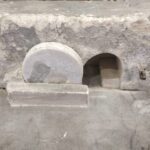The way of salvation is the way of knowing and believing Jesus – the Bible is clear on that (Acts 4:12). Thomas’ recognition and acceptance of the person of Jesus as God, and as Lord of his life shows who Jesus was, and is – Son of God, Messiah, Lord of life and death. Thomas’ response is not just the high point, the climax of the entire Gospel but tests of a true believer – Jesus is the risen Lord, a confession of personal faith, ‘My Lord, and my God.’ Thomas’ response to Jesus’ resurrection with the help of the Holy Spirit remains the reassurance for everyone, family, or church who is, like him, a ‘late adopter.’
In John 20 Jesus puts His final touches on the empowerment of His twelve, commissioned and sent them into the dysfunction of the world. Jesus gives His peace and breathes on His disciples to receive the power of the Holy Spirit, a spiritual foretaste of the Pentecost experience to come (vs 21-22). The Holy Spirit is our boldness and clarity in making Christ known. The Holy Spirit is also the conviction of either righteousness or unrighteousness that comes on those who hear (Jn 16:7-8). This peace and power of the Holy Spirit would enable the disciples to serve supernaturally without doubt, worry or anxiety. When Jesus gave the Holy Spirit to His disciples on the day He rose from the dead, He was not “baptising” them in the Spirit as the disciples would experience later during Pentecost (Act1:5; 2:4). The reflection is that, this was the first time the disciples actually received the spiritually renewing presence of the Holy Spirit – the same Spirit that raised Jesus from the dead (Rom 8:11). The Spirit would now live within them. The inner presence of the Holy Spirit is part of the new life that all Christ’s followers now receive at the time they accept Christ’s forgiveness and surrender their lives to Him.
The phrase by John, “He breathed on them” points to the Greek verb word for “breathe” emphusao as used in Genesis where God “breathed into his (Adam’s) nostrils the breath of life, and man became a living soul” (Gen 2:7). The same verb is found in Ezekiel, “Breathe upon these slain, that they may live.” John’s usage of this verb suggests that Jesus was giving the Holy Spirit in order to bring life and “a new creature” (2 Cor 5:17). Jesus through His resurrection became a “quickening (life-giving) spirit” (1 Cor 15:45). He breathed on the disciples and they each became a new creation in a spiritual sense, a new birth into a personal relationship with Jesus Christ (2 Cor 5:17-18). Jesus’ resurrection granted the disciples the full new covenant, the “life agreement” based on Jesus’ life, death and resurrection (Matt 26:28; Lk 22:20).
Thomas, as one of Jesus’ twelve disciples had gone off on his own. Thomas provides us one of the modern responses to the reality of Jesus’ resurrection, the “Unless … I will not believe” attitude and theology. Jesus’ teachings during His post-resurrection appearances is better understood through Thomas. Thomas in his isolation and grieving not only missed the meeting with Jesus Christ, he became resentful in attitude and words, “Unless … I will not believe.” Thomas response to the reality of Jesus’ resurrection reminds us that there are many more Thomases down through history who wrestles with the same question of the resurrection. Thomas was a modern man and church, finding faith hard. Peradventure, Thomas was let down by leaders that denied Jesus or by others who renounced the faith. The truth is that, it was in the Christian community, the disciples found faith in the risen Christ. Separation from from Christian community makes Christian faith difficult and gives opportunity to heresy. Christian faith is first personal with the example of Thomas, but it is in the faith of one, the faith of another may be strengthened.
John Wesley explained that there was no holiness but social holiness based on the context of the necessity for Christian fellowship. Thomas’ privatised faith in response to the reality of Jesus’ resurrection warns against the unbeliever who thrives on doubts and unending debates. Thomas’ privatised faith invite us to distinguish between the honest doubter or debater and “the evil heart of unbelief.” Unbelief puts self where God should be.
The dishonest doubter has a deep reluctance to be convinced by the objective Gospel truth just as a ‘true skeptic will openly, honestly seek the truth regardless of the outcome. An honest doubt is one thing, but a stubborn heart of unbelief is another.’ Jesus not only countered a privatised conditional Thomas’ faith and theology that wanted to established for Jesus Christ how He needs to operate in our lives. Privatised conditional Thomas’ faith and theology is based in what we demand from God, rather than in what God does in Jesus Christ and through the Holy Spirit.
Jesus answered Thomas’ question on the reality of Jesus resurrection by answering ours today. The Thomas in us and in the church today still replicate the folly of a privatised conditional faith and theology. Response to the reality of Jesus’ resurrection reminds us that believing is neither a matter of physical proofs nor having our conditions met. The missional response to the reality of Jesus’ resurrection beyond a matter of seeing involves being transformed by Jesus’ Word (Jn 1:14, Jn 20:20, 27-28). The missional and confessional declaration of Thomas’ conviction as to who Jesus Christ, “My Lord and my God” is, calls us to a renewing expression. Thomas’ words and unchallenged utterance are the climax of the entire Gospel. Thomas, without examining Jesus’ hands and side was ashamed of his unbelief, hence he owns Jesus to be Lord, as He was ‘both by creation and redemption; and God, of which he was fully assured from His omniscience.’ Thomas’ response invites us to assert our interest in Jesus as our Lord and our God which denotes our subjection to Jesus, our affection for Him and faith in Him. Charles Wesley in one of his hymns points us to the climax of the entire gospel. He calls us in humble surrender to seek the Lord, our God with contrite hearts
All
ye that seek the Lord Who died,
Your God for sinners crucified,
Prevent the earliest dawn, and come
To worship at His sacred tomb.
Bring
the sweet spices of your sighs,
Your contrite hearts, and streaming eyes,
Your sad complaints, and humble fears;
Come, and embalm Him with your tears.
While
thus ye love your souls t’employ,
Your sorrow shall be turned to joy:
Now, let all your grief be o’er!
Believe, and ye shall weep no more.
An
earthquake hath the cavern shook,
And burst the door, and rent the rock;
The Lord hath sent His angel down,
And he hath rolled away the stone.
As
snow behold his garment white,
His countenance as lightning bright:
He sits, and waves a flaming sword,
And waits upon his rising Lord.
The
third auspicious morn is come,
And calls your Savior from the tomb,
The bands of death are torn away,
The yawning tomb gives back its prey.
Could
neither seal nor stone secure,
Nor men, nor devils make it sure?
The seal is broke, the stone cast by,
And all the powers of darkness fly.
The
body breathes, and lifts His head,
The keepers sink, and fall as dead;
The dead restored to life appear,
The living quake, and die for fear.
No
power a band of soldiers have
To keep one body in its grave:
Surely it no dead body was
That could the Roman eagles chase.
The
Lord of Life is risen indeed,
To death delivered in your stead;
His rise proclaims your sins forgiv’n,
And show the living way to Heav’n.
Haste
then, ye souls that first believe,
Who dare the Gospel-Word receive,
Your faith with joyful hearts confess,
Be bold, be Jesus’ witnesses.
Go
tell the followers of your Lord
Their Jesus is to life restored;
He lives, that they His life may find;
He lives, to quicken all mankind.










Recent Comments